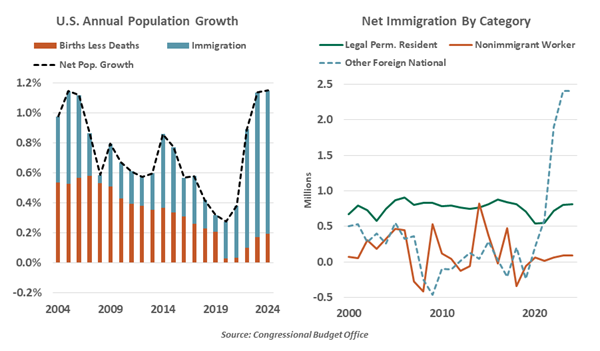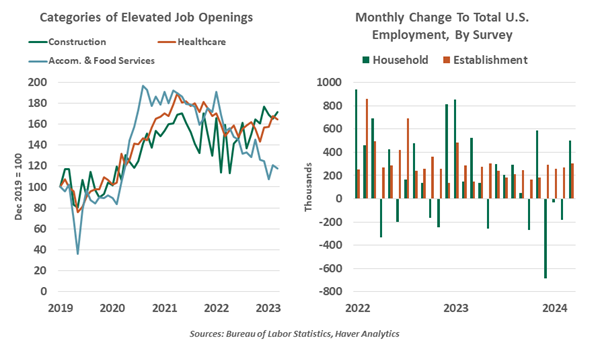- Who We Serve
- What We Do
- About Us
- Insights & Research
- Who We Serve
- What We Do
- About Us
- Insights & Research
New Waves Of Immigration
Immigration is coming up everywhere, including economic data.
By Ryan Boyle
Among the liveliest elements of our work are question-and-answer segments when we present to clients. We never know what will come up. The thorniest question I have received of late was, “What do you think of the immigration problem?”
This query comes both from those who perceive that the U.S. has allowed in too many immigrants and others who think we need more newcomers to address a shortage of workers. Answering is also complicated by the challenge in assessing just how many new entrants have arrived. Recent work on this latter front has placed the immigration debate front and center.
Immigration has always been a contentious but fundamental component of the dynamic U.S. labor market. The American economy wouldn’t be the world leader without immigrants, but the continual inflow of migrants at the southern border has raised questions over whether the current state is helpful or harmful to growth and inflation. That is what we will focus on, preferring to leave policy questions to politicians.

Estimates of the population change due to activity at the southern border are wide ranging, but uniformly upward. Pre-COVID, the nation could expect about 900,000 working immigrants per year. Among official approximations, the Congressional Budget Office (CBO) has published the highest estimate of 3.3 million arrivals in 2023. The CBO’s inclusion of the “other foreign nationals” arriving in the busy second half of 2023 gives credibility to their estimate.
Most recent arrivals are attempting to stay in the country through processes that sidestep conventional visa eligibility. Parole and asylum statuses grant safe haven but leave the migrants in a state of legal limbo. The immigration court backlog stands at over 3.4 million cases; the asylum process takes five years from filing to reach a decision.
However, roughly six months after starting these processes, migrants can gain work authorization. About half of asylum claims are denied, but that still grants many productive years in the United States.
The surge in immigration explains some recent oddities in the employment data.
The recent wave of immigration has some positive aspects for the U.S. economy. A nation’s potential output is the product of its working-age population and the output of those workers. More workers means more productive activity, and the children accompanying them will support the labor force as they mature. And in a consumption-led economy like the U.S., more people means more demand for goods and services.
More newcomers will help to close shortages in the labor market. Past generations of immigrants had high rates of employment, filling jobs at the low end of the wage scale. More hiring of lower-paid workers can help to limit wage-driven inflation. As the new workers acclimate, their productivity rises, allowing for non-inflationary wage gains. Recent hiring has been strongest in the hospitality and healthcare sectors, common first jobs for new immigrants and areas where additional hands have been needed.

Migrant flows are difficult to measure, but impossible to ignore.
The migrant flow also helps to explain some of the curiosities of employment data in the past year. The payroll (or establishment) survey has shown extranormal increases over the past year; but the household survey has reflected declining employment and labor force participation. We can now see that immigration grew the population faster than employers were hiring. New entrants taking payroll jobs were reflected immediately in the establishment survey, giving greater confidence in the signal from that figure. The unemployment rate may rise further as the population grows, but it will not be the same signal of economic distress that it was in past cycles.
Upon arrival, migrants need basic necessities like food, clothing, shelter and education. Demand for these goods and services will rise, and prices may follow. Added demand for housing comes at an inopportune time. The costs are not borne evenly, as border regions and sanctuary cities stretch their budgets to bring newcomers into their local education and social support systems.
Immigration will figure prominently in the 2024 election. Recent policy swings have been entirely through executive action. A change in leadership could abruptly end all accommodative programs and halt the migrant flow; continual strain on local resources could prompt action even before the election. The flow may naturally dwindle as those most motivated to migrate have made their moves, but such an inflection is difficult to predict. Canada offers a cautionary tale: its permissive immigration stance led to greater population growth than had been estimated, requiring changes to some of its policies. We expect those who have arrived in the U.S. will stay, as a mass expulsion of those who followed immigration protocols would be an economic shock with little precedent.
The question of the “immigration problem” is far from resolved. The more we dig into the research, the more questions arise. We can be certain that the flow of immigrants is having a profound impact on the economy today, and will place the issue at the forefront of electoral debates. Long-run benefits of immigration must be balanced against immediate resource constraints. The conversations can be tense, and the solutions difficult, but arriving at a cohesive policy response is essential.
Related Articles
Read Past Articles
Meet Our Team

Carl R. Tannenbaum
Chief Economist

Ryan James Boyle
Chief U.S. Economist

Vaibhav Tandon
Chief International Economist
Subscribe to Publications on Economic Trends & Insights
Gain insight into economic developments and our latest forecasts for the United States.
Information is not intended to be and should not be construed as an offer, solicitation or recommendation with respect to any transaction and should not be treated as legal advice, investment advice or tax advice. Under no circumstances should you rely upon this information as a substitute for obtaining specific legal or tax advice from your own professional legal or tax advisors. Information is subject to change based on market or other conditions and is not intended to influence your investment decisions.
© 2025 Northern Trust Corporation. Head Office: 50 South La Salle Street, Chicago, Illinois 60603 U.S.A. Incorporated with limited liability in the U.S. Products and services provided by subsidiaries of Northern Trust Corporation may vary in different markets and are offered in accordance with local regulation. For legal and regulatory information about individual market offices, visit northerntrust.com/terms-and-conditions.